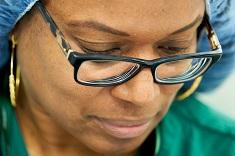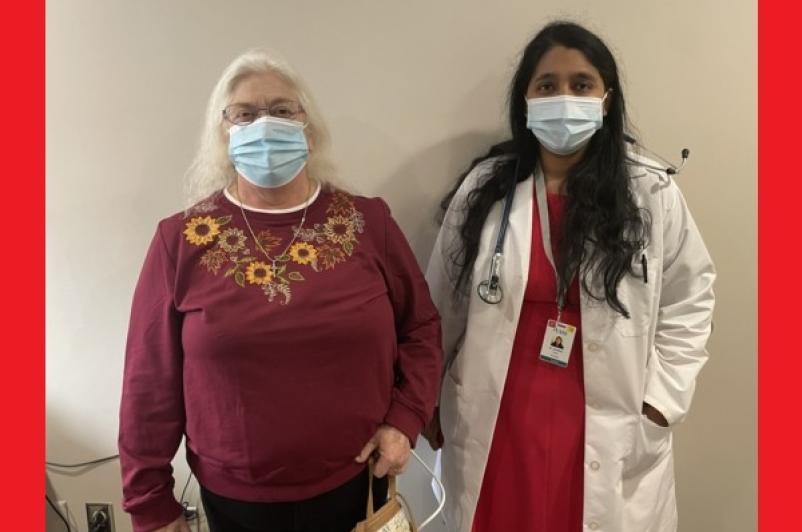
Three years ago, Lynne Eggler of Unadilla was a Verizon retiree who had started a second career as an aide and janitor in the Unatego Central School District. Her life was suddenly interrupted by a massive heart attack.
She received emergency care at a hospital in Sidney, N.Y., and was transferred to UHS Wilson Medical Center. At UHS, her physician called her husband John to let him know that they were sending Ms. Eggler to a Rochester hospital for further care.
“It was a major attack,” she said. “At one point I flat-lined.”
It was clear that, to recover, she would need the latest in life-sustaining medical intervention.
Ms. Eggler was dealing with a condition that hampered the pumping of blood from the bottom of her heart to the top. Her physicians determined that she was a good candidate for the implanting of a left ventricular assist device (LVAD), as well as a defibrillator.
The surgically implanted LVAD is a battery-operated mechanical pump that helps the left ventricle (the heart’s main pumping chamber) to send blood to the rest of the body.
Within the past few years, LVADs have become portable, meaning that the patient can return home with the device and resume a fairly routine lifestyle, with some limitations.
“There is a cable that goes through my stomach,” Ms. Eggler said. “At night the unit plugs into an electrical outlet. The rest of the time I have a backpack with two large batteries that I charge. Smaller batteries are coming in soon, and I can hardly wait.”
Formerly an avid swimmer, she has had to give up that sport, but said she continues to stay busy with gardening and other activities she enjoys.
Along the way she has had great support from her husband, a retiree who worked for a number of years as a handyman at Hartwick College.
“He’s a terrific helper,” she said. “John is my caregiver, and my step-daughter Lisa Corbett is my second caregiver.” They assist with any aspect of home care that may be needed, including bandage-changing.
When Ms. Eggler goes for checkups, her physicians are very impressed with how well she’s progressing.
“I’ve gotten to a healthy weight and they can’t get over how strong my grip is,” she said. “I’m doing better, and, without this unit, I wouldn’t be here.”
The follow-up monitoring and care that Ms. Eggler receives at UHS is a new, highly beneficial service offered to patients by cardiologist Rasha Aurshiya, MD, at the Heart & Vascular Institute.
“This is an exciting service because, now, LVAD patients can come here for most of their checkups instead of having to travel out of town,” said Bridget Metzler, director of Cardiac Services at UHS Hospitals.
UHS has a special relationship with two hospitals in Rochester and one in New York City to provide follow-up care for their LVAD patients, Ms. Metzler said.
In conjunction with “National Wear Red Day,” Friday, Feb. 4, Ms. Eggler is bringing a message of strength and encouragement to other heart patients who are contemplating having an LVAD implant or are currently living with one.
She said she has become the LVAD ambassador for the Southern Tier region, explaining to other patients the benefits of the implantable device and the hope it beings for a better life for those with severe cardiovascular issues.
John M. Carrigg, president and chief executive officer of UHS, praised Ms. Eggler for helping to educate providers about the LVAD and encouraging people across the Southern Tier to wear something red Feb. 4 as a way of raising heart health awareness.
“Wearing something red is a great reminder of the importance of focusing on women’s heart health,” he said. “It’s about all of us standing together with the ‘Go Red for Women’ movement to beat heart disease. It’s about taking preventive action, understanding symptoms and seeking out the right treatment at the right time.”
Dealing with a serious heart condition and choosing a lifesaving treatment option have prompted Ms. Eggler to share her story with others.
“The more people are aware of it, the better off we are,” she said. “When I go to see people, I let them know that I’ve been there like they have and have gone through what they’re going through. I tell them, ‘You’ll get there.’”
In some cases, patients who are candidates for heart transplantation go on an LVAD for a period of time while awaiting a donor heart. For patients like Ms. Eggler, the implant itself is the solution to their condition.
And physicians-in-training, such as medical fellows at UHS, are eager to learn much from Ms. Eggler’s experience.
On Jan. 28 she traveled to the Heart & Vascular Institute at UHS Wilson to meet with members of the Internal Medicine Residency Program’s Cardiovascular Disease Fellowship.
She is only too glad to talk with the medical fellows about her experience with the device, including everything she has gone through and how the implant has given her new life.
“They listened to my heart and saw how the LVAD works,” she said.
National Wear Red Day is part of the American Heart Association’s “Go Red for Women” campaign, raising awareness about the prevalence of heart disease in women and the many steps that can be taken to prevent and treat it.
On the first Friday of each February, Wear Red Day ignites a wave of red from coast to coast, as women, men and children alike wear something red to raise the level of public awareness.
The groundswell unites millions of people for a common goal: the eradication of heart disease and stroke.


